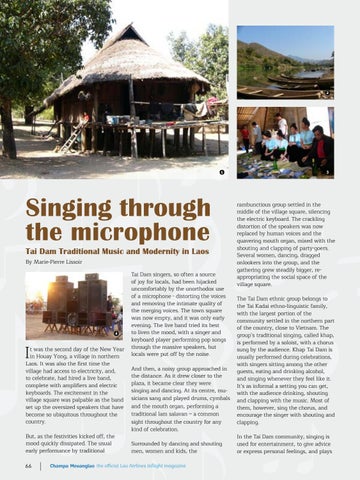2
1
Singing through the microphone Tai Dam Traditional Music and Modernity in Laos By Marie-Pierre Lissoir
4
I
t was the second day of the New Year in Houay Yong, a village in northern Laos. It was also the first time the village had access to electricity, and, to celebrate, had hired a live band, complete with amplifiers and electric keyboards. The excitement in the village square was palpable as the band set up the oversized speakers that have become so ubiquitous throughout the country. But, as the festivities kicked off, the mood quickly dissipated. The usual early performance by traditional
66
Tai Dam singers, so often a source of joy for locals, had been hijacked uncomfortably by the unorthodox use of a microphone - distorting the voices and removing the intimate quality of the merging voices. The town square was now empty, and it was only early evening. The live band tried its best to liven the mood, with a singer and keyboard player performing pop songs through the massive speakers, but locals were put off by the noise. And then, a noisy group approached in the distance. As it drew closer to the plaza, it became clear they were singing and dancing. At its centre, musicians sang and played drums, cymbals and the mouth organ, performing a traditional lam salavan – a common sight throughout the country for any kind of celebration. Surrounded by dancing and shouting men, women and kids, the
3
rambunctious group settled in the middle of the village square, silencing the electric keyboard. The crackling distortion of the speakers was now replaced by human voices and the quavering mouth organ, mixed with the shouting and clapping of party-goers. Several women, dancing, dragged onlookers into the group, and the gathering grew steadily bigger, reappropriating the social space of the village square. The Tai Dam ethnic group belongs to the Tai Kadai ethno-linguistic family, with the largest portion of the community settled in the northern part of the country, close to Vietnam. The group’s traditional singing, called khap, is performed by a soloist, with a chorus sung by the audience. Khap Tai Dam is usually performed during celebrations, with singers sitting among the other guests, eating and drinking alcohol, and singing whenever they feel like it. It’s as informal a setting you can get, with the audience drinking, shouting and clapping with the music. Most of them, however, sing the chorus, and encourage the singer with shouting and clapping. In the Tai Dam community, singing is used for entertainment, to give advice or express personal feelings, and plays




